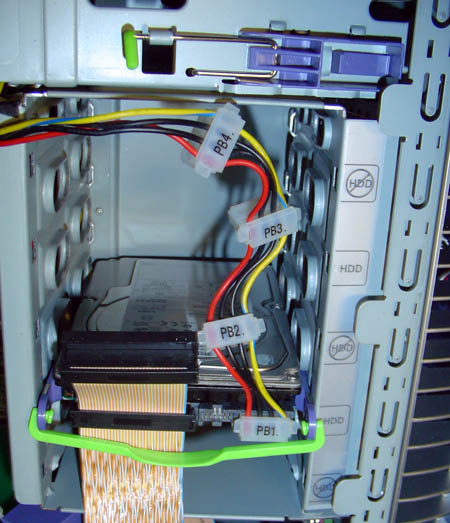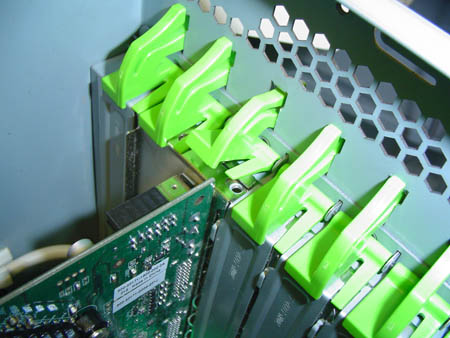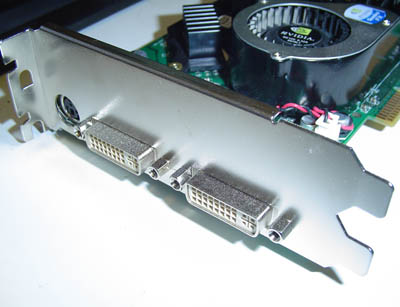Sun's W2100z Dual Opteron Workstation
by Kristopher Kubicki on October 27, 2004 12:05 AM EST- Posted in
- Systems
Putting It All Together
The immediate difference between a whitebox configuration and the Sun w2100z is the level of design and attention to detail. Our w2100z only comes with one system fan, a 120mm exhaust. An 80mm exhaust fan provides cooling inside the power supply, and each processor also incorporates 80mm fans in their design - we will go into more detail about the heatsink fan (HSF) design in the thermal section of the analysis. There are no intake fans on the workstation. Sun relies on enormous amount of passive cooling for the workstation. For example, only two hard drives may be placed in the system and they must be placed a bay apart from each other. You can see an example of this below.You can see from the image that alternating bays are marked for cooling rather than hard drive storage. Two hard drives may seem like the bare minimum for a performance workstation, particularly if any sort of PVR work is in order, but the fact that Sun can passively cool both drives and the rest of the machine without any intake might be a design win in itself. Also notice the somewhat unique screwless plastic rails on the drive. Pulling the green handle unclips the purple rails and allows us to slide out the drive.
As long as we are on the subject of tool-less design, we were also particularly impressed with Sun's approach to the expansion bay. Below, you can see the green retention clips holding the PCI/AGP cards in place.
Removing an expansion card requires us to pinch the green clip from the outside of the case and then lift it up. For those of you who follow our case reviews closely, this is an excellent, well thought out design. Cable management was not as perfected as some other system builds that we have seen in the past, particularly along the power supply. While not overwhelming, Sun could use a slight bit of improvement in this area, particularly since they have gone through so much care to label and document each port and cable clearly on the system.
Although the tool-less design of the case is an excellent design win, the heavy weight of the system was surprising. The Sun website lists the shipping weight of the workstation at just under 60lbs! Most of this weight seems to stem from the all-steel construction of the case - the motherboard mounting plate seems almost to be reinforced with additional steel. Additional steel may have some passive cooling qualities, but we do not have the ability to test that theory. The aluminum front bezel deceives us into thinking that the workstation is much lighter than it really is, but then again, most people don't lug their high end workstations around after the initial setup all that often anyway.

Below you can see the standard IO specifications for the system. Again, keep in mind the included keyboard and mouse use up 2 of the 5 USB ports.
| Sun w2100z System Specifications | |
| 5.25" Expansion Bays | 3 |
| 3.5" Expansion Bays | 4, 2 usable |
| Rear USB Ports | 3 |
| Forward USB Ports | 2 |
| Rear Firewire Ports | 1 |
| Forward Firewire Ports | 1 |
| On-Board Parallel Port | 1 |
| On-Board Game Port | 0 |
| On-Board Serial Ports | 2 |
| Front Audio Jacks | 1 in, 1 out |
| Rear Audio Jacks | 1 in, 1 out |
| SPDIF | 1 |
| Number of Fans (including CPU/chipset) | (1) 120mm exhaust (2) 80mm CPU |
| Power Supply | 550W AcBel |
Sun included various other components for our analysis of the w2100z. The included QuadroFX 3000 (~GeForceFX 5900) is important for our OpenGL SpecViewperf benchmarks, but can be upgraded fairly easily. Our FX 3000 is a dual DVI video card, but Sun includes two DVI to D-sub 15 dongles for CRT users.
Our Sun w2100z can make use of 16GB of PC-3200 DDR by default. We are only using 4GB of buffered ECC memory as seen below. The Micron DIMMs utilize a BGA chip design.














47 Comments
View All Comments
t - Thursday, October 28, 2004 - link
oh... i better clarify before i get labelled as a 'zealot' or a 'mac hater' or a 'pc lover'by 'cache starved' i mean that the power4 is _very_ dependent upon its cache architecture, take some of that away and u of course impact performance... a power4 and a G5 at the same clockspeed, the power4 wins. The G5 is still an impressive chip.
t.
t - Thursday, October 28, 2004 - link
heh...this thread is hilarious...can u ppl like talk past each other some more?please :)
G5 = cut down, somewhat cache starved power4
Blue Gene/L = power4+
they are a fair bit different: l3, l2, altivec, dual v. single core...just for a couple.
gromm - Wednesday, October 27, 2004 - link
"and I'm sure that there's nothing special about the way the G5's were linked... "Actually, they have a communication network based on InfiniBand, which isn't something that you'd buy for home (especially considering how much it costs). The cards themselves are $200+ each (in quantities of 10,000 for the only price I could find for their HCA cards) and I can't even find how much the switches cost (I'm sure several thousand dollars each).
Reflex - Wednesday, October 27, 2004 - link
Thanks for the correction, its been a while since I read up on that stuff. However you still illustrated my point that this is pretty much an irrelevant benchmark for general purpose computing. People do not simply use thier PC's for floating point performance...slashbinslashbash - Wednesday, October 27, 2004 - link
Reflex: "First off, once again, you are misunderstanding what you are looking at. Total number of CPU's is only part of the equation. There are *many* factors that go into the 'most powerful supercomputer' equation. How much memory and what type/speed? How are they linking the individual nodes? What kind of software optimizations have been done, and what software is being used to benchmark it?"Wrong. The top supercomputers are rated solely by FLOPS (Floating Point Operations Per Second, as I'm sure you know) as measured by the Linpack benchmark. See www.top500.org. I've never heard of memory having an impact on FLOPS; I guess it *could* if you absolutely starved the CPUs of work, but presumably all of these computers are balanced enough that the RAM can keep up with the CPUs. The nodes can be linked in any way; presumably they're linked optimally for price/performance, and I'm sure that there's nothing special about the way the G5's were linked... you don't build a supercomputing cluster and let the linking drag the performance down. As for the optimization question, I'm not sure but I'll bet Linpack is optimized for every platform/architecture.
Reflex - Wednesday, October 27, 2004 - link
I have not been arguing about superiority for the PC platform. My point is that they are not directly comparable as related to this particuliar review. The product being reviewed does not have an equivilent on the Mac side of things, so going on about how this article proves that the 'price' arguement is wrong is rediculous.My original question has not been answered, and that is that I am wondering who is building these since I have an identical workstation here on my lab bench but with an IBM label on it.
karlreading - Wednesday, October 27, 2004 - link
enuff of the mac vs. pc B$ dudes!!!this is a comments section about a opteron workstation, not about how a g5 spanks / get spanked by opterons ass.
that said there is one part of this that gets me excited. Whilst coming across mac / pc arguments on forums, i have noticed one trend. AMD is now always the PC's defender. i never hear anybody citing the p4 / xeon as a mac comparison. its always opteron / a64 vs. g5. this is excellent news from AMD's standpoint, as it cements the trend that AMD is a respectable company, and also is impressive to see AMD as the lead PC saviour in the ongoing annoying "my pc's better than your mac " debate. Intel should be worried, very very worried. never thaught id see the day when my beloved AMD were championing the pc / x86 cause :)
gromm - Wednesday, October 27, 2004 - link
As far as cost, I'd like to see how much Apple (and other sponsors) subsidized X. The networking infrastructure it has alone would normally be massively expensive and I can't see how it fits into the $10M pricetag quoted by them along with all compute hardware.From benchmarks I have run, the G5 and the Athlon64 are neck-to-neck in performance (actually the difference is small enough to be noise) in 'normal' codes (mostly FPU) and the Athlons are a little faster in integer performance. I haven't seen what Altivec/SSE2 optimizations would do for either.
If you want some rough estimates, go to Ars Technica and look in the Battlefront forum under the Cinebench thread. There are lots of scores under there to compare for this benchmark (includes a raytracer and some other stuff).
michael2k - Wednesday, October 27, 2004 - link
I'd like to see Anand run SpecViewPerf on his Dual G5, now :)Reflex - Wednesday, October 27, 2004 - link
I am aware of Apple's 'server' aspirations. That does not change anything at all. They do not have the kind of corporate support Sun or other large venders provide, and as a result the Xserve is not a large player in the market. Furthermore, its only proof that your comparing the wrong product to the Sun product this review was about. Xserve was designed to compete with workstations like this, not the PowerMac which is a desktop system.My comment about Sun relates to the fact that for a long time they were a detriment to the industry at a whole, pushing concepts like Java PC's with no local storage, trying to keep prices very high, and generally siding with 'Big Iron' in the market rather than embracing the future. In the past year, as Microsoft/Intel/AMD have made the Sparc obsolete they have had to get with the program, choosing AMD as their partner made perfect sense as they had no motivation to improve Intel's position considering they are still competing with them in some markets.
In summation, Sun is finally seeing the light, however their past is one of high prices, legal shennanigans(especially in Europe where price fixing has been a common charge against them), and a strategy of defining themselves as Microsoft/Intel's opposition rather than charging their own course. The future will tell where they go, and I'll cross my fingers and hope that x86 Solaris and Opteron workstations are a sign that they are finally producing products their customers demand, rather than locking them into a model and then telling them what they need...